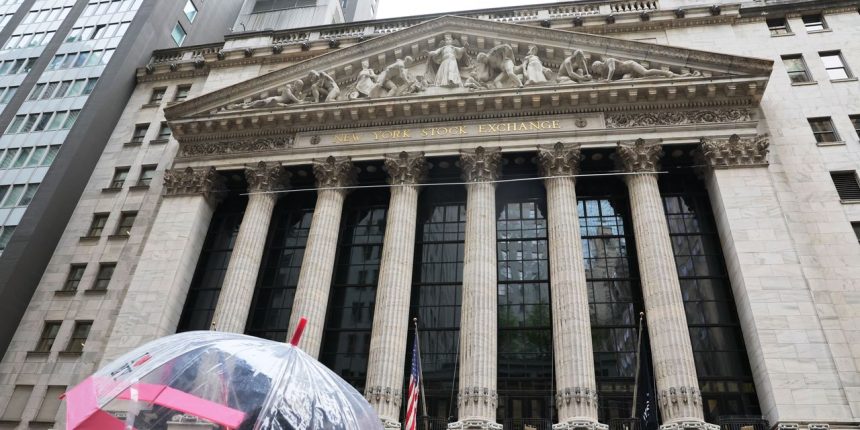Stock-market strategists have been complaining about the dangers of a lopsided U.S. equity market all year. Now it looks like those concerns are finally being validated as the market sinks, with the best performers leading the way lower.
Since the S&P 500 reached its 2023 closing high of 4,588.96 on July 31, the index has fallen 5.5%, according to FactSet data through Friday’s close. Over the same period, most members of the so-called Magnificent Seven group of megacap technology stocks have underperformed, with Apple Inc.
AAPL,
down 10%, Microsoft Corp.
MSFT,
down 5.8% and Nvidia Corp.
NVDA,
the chip maker that has been the star of this year’s U.S. stock-market rally, down 9.4%.
Despite these recent losses, the seven largest stocks in the S&P 500 are still up more than 50% year to date, while the remaining 493 companies in the index have barely gained 5%, according to Torsten Slok, chief economist at private-equity giant Apollo Asset Management.
“The bottom line is that if you buy the S&P 500 today, you are basically buying a handful of companies that make up 34% of the index and have an average [price-to-earnings] ratio around 50,” Slok said in emailed commentary.
In addition to Apple, Microsoft and Nvidia, the Magnificent Seven includes Amazon.com Inc.
AMZN,
Facebook owner Meta Platforms Inc.
META,
Tesla Inc.
TSLA,
and Alphabet Inc.’s Class A
GOOGL,
and Class C shares
GOOG,
Thanks to the artificial-intelligence craze, these stocks have driven the S&P 500 and Nasdaq Composite
COMP
higher all year and are responsible for the bulk of those indexes’ outsize performance compared with other popular equity indexes like the Dow Jones Industrial Average and the small-cap-focused Russell 2000
RUT.
While the valuation gulf between the Magnificent Seven and the rest of the U.S. equity market didn’t pose much of a problem on the way up, it could exacerbate losses now that stocks are caught in a downdraft driven by rising Treasury yields, according to an analysis of historical market data by BTIG’s Jonathan Krinsky.
Perhaps the only antidote to this would be a rotation into laggards in the equity space. But so far, there have only been cursory signs that this might happen, while most sectors have fallen alongside the Magnificent Seven.
To anticipate how this might play out, Krinsky looked at periods when the market met the following criteria:
- The S&P 500 was trading above its 200-day moving average.
- The index had fallen 2% or more over the prior two months.
- The S&P 500 equal-weighted index was trading 2% or more below its moving-day average.
What he found seemed ominous enough: As lopsided markets fall back to Earth, there’s the potential for losses to accelerate. There have only been five times when the market met all three criteria: August 1998, January 2000, September 2007, October 2018 and March 2020. In almost every example, a more prolonged and punishing downturn ensued.
But that’s not all. A look at broader stock-market performance shows breadth has deteriorated markedly over the past couple of months as the indexes have declined. While the Russell 3000
RUA,
intended to be a gauge of the entire U.S. stock market, remained above its 200-day moving average, only about one-third of its components are trading above their 200-day moving averages, another example of how a small number of stocks are distorting performance of broad equity indexes.
By comparison, that number was 70% back in February, when the 2023 stock-market rally was still in its formative stages, according to details included in Krinsky’s latest note to clients, shared with MarketWatch on Monday.
As the yield on the 10-year Treasury note
BX:TMUBMUSD10Y
climbs to fresh 16-year highs on Monday, many analysts are questioning whether increased competition in bonds will continue to lure capital away from stocks.
Deutsche Bank’s Jim Reid noted that the 10-year yield at 4.5% puts it in line with its long-term average dating back more than 200 years. Bond yields move inversely to bond prices.
Historically, equity valuations relative to expected corporate earnings have been much lower than current levels, especially for the S&P 500. As yields continue to push higher, could investors see high-flying tech stocks crash back to Earth, bringing the broader market indexes with them?
“If you can get over 5% on cash, and around 4.5% on longer-dated Treasuries, then what return do you need on equities? Clearly fixed income and deposit rates might not stay at these levels, but at the moment this is a very different competitive landscape than the [zero-interest-rate policy] world of the decade or so before 2022,” Reid said in a note shared with MarketWatch early Monday.
Read the full article here




